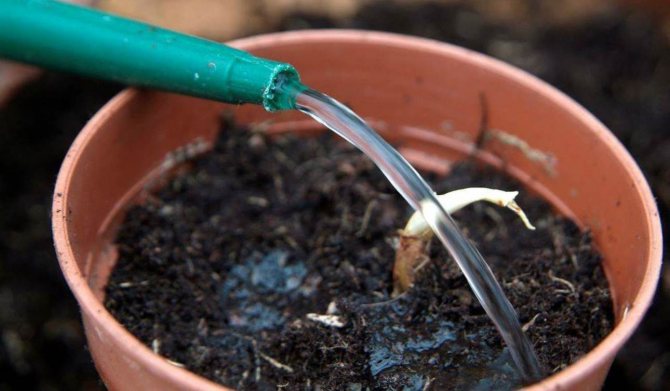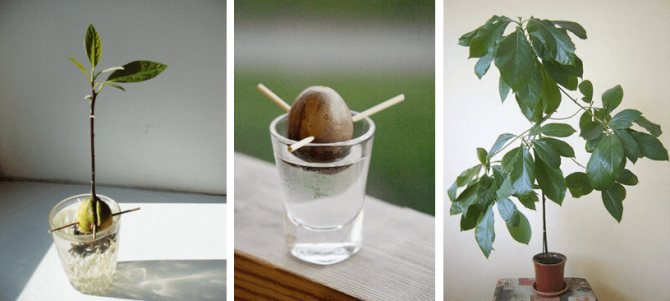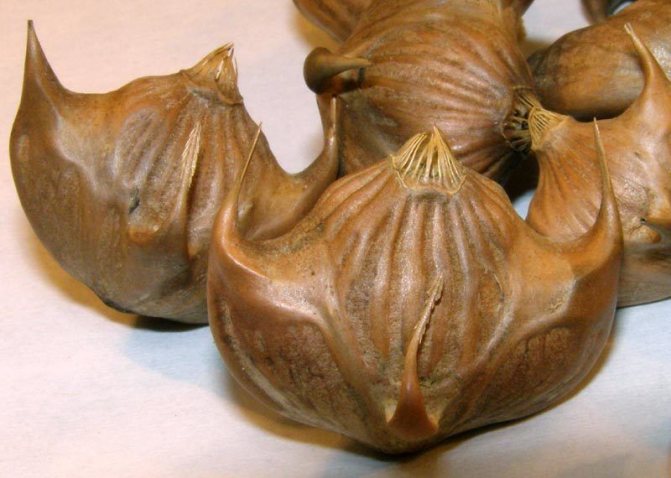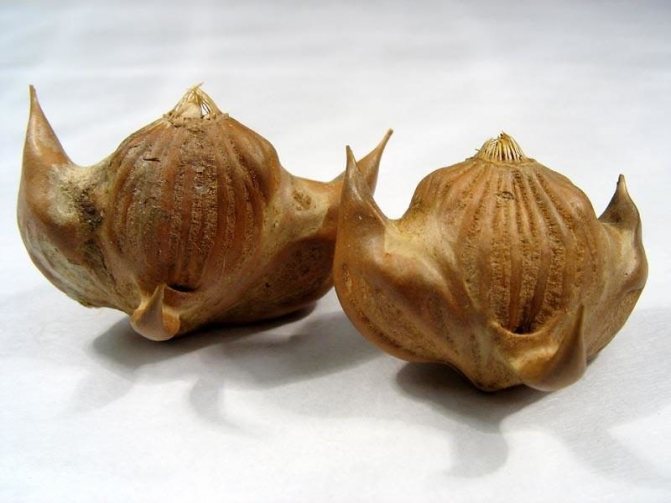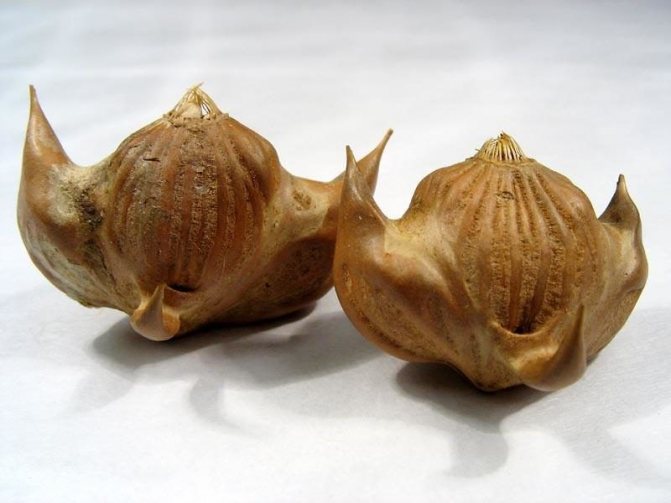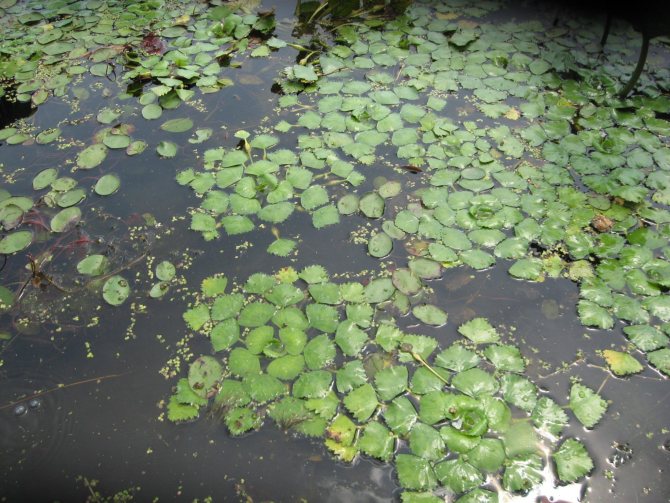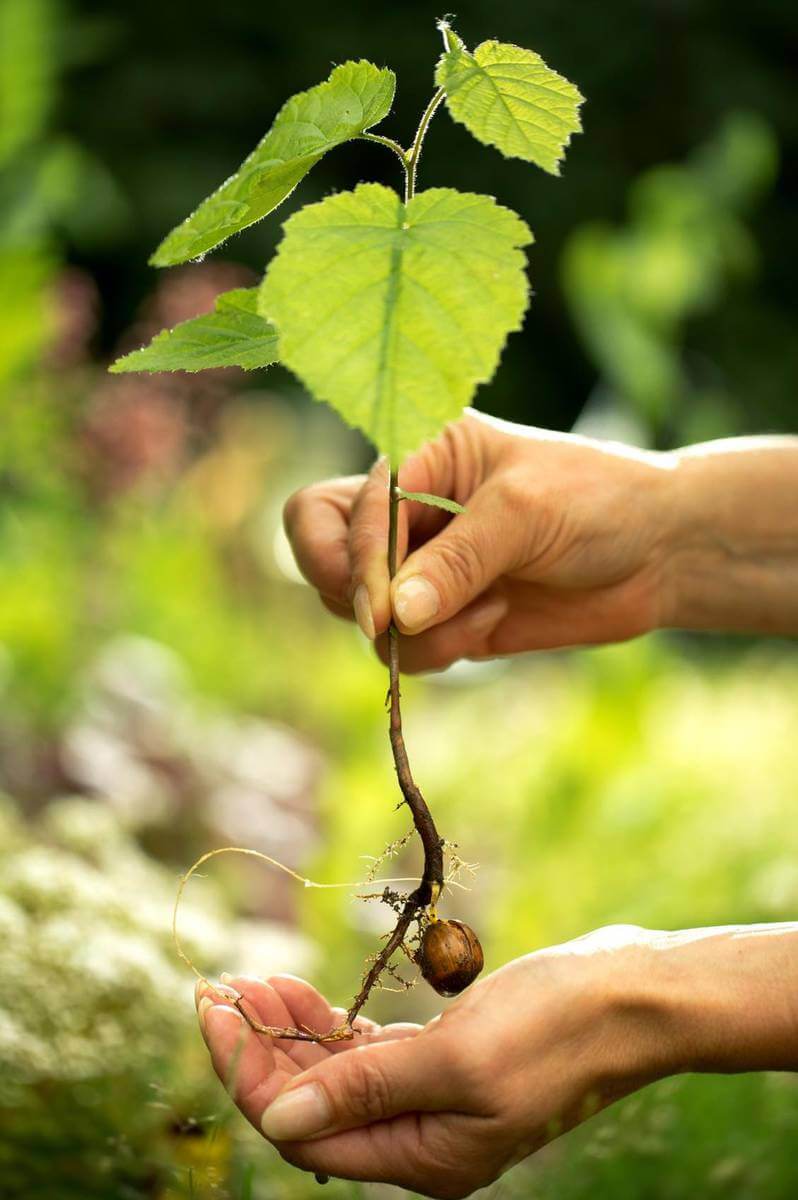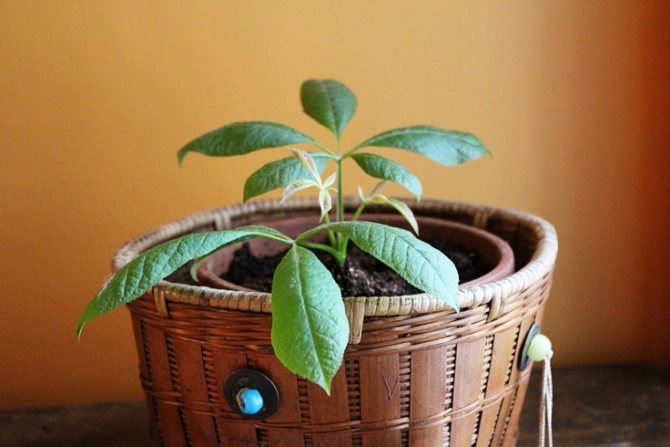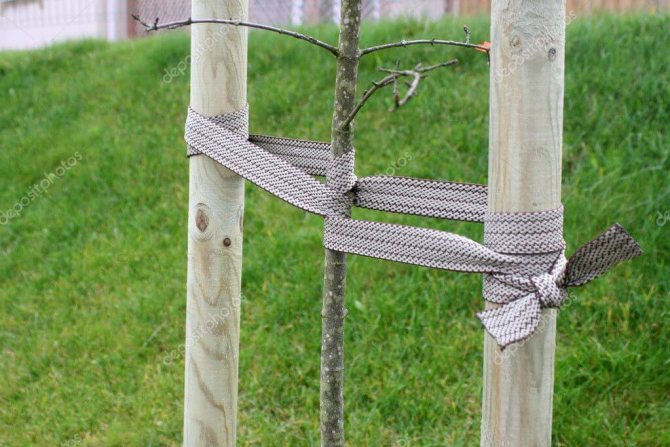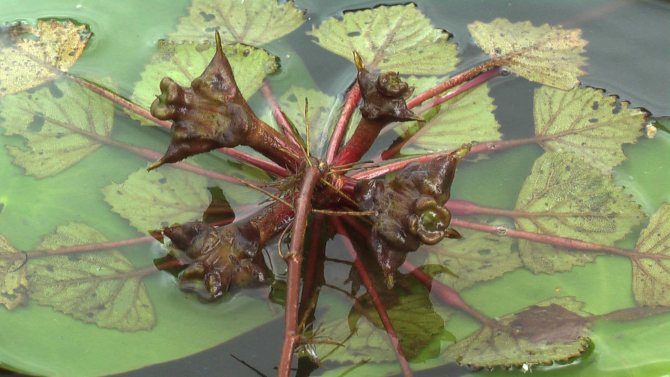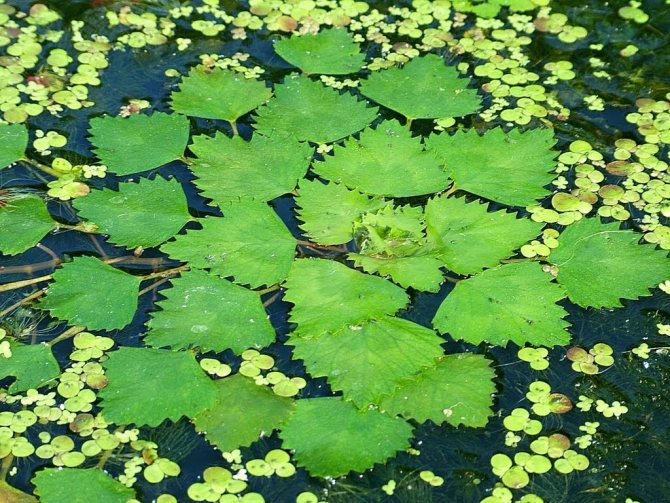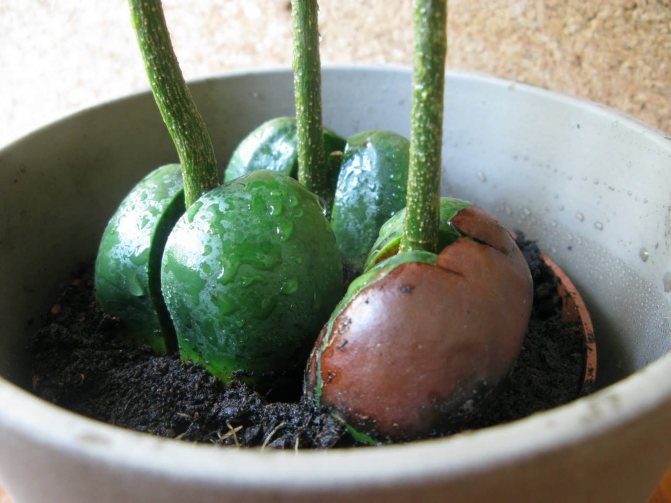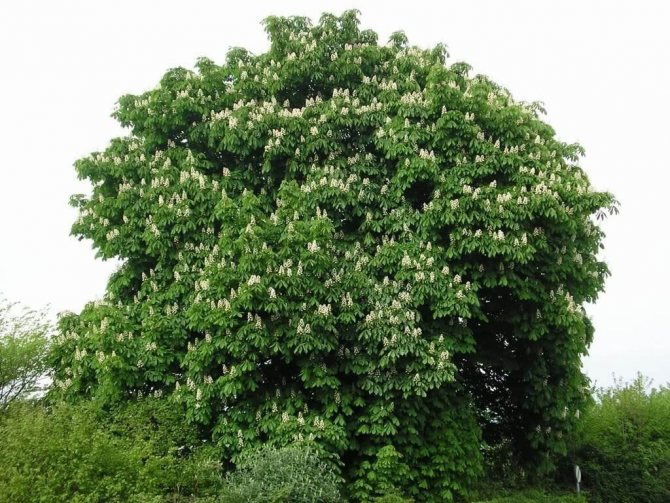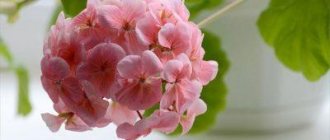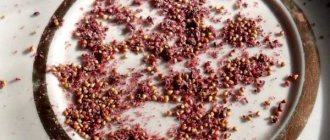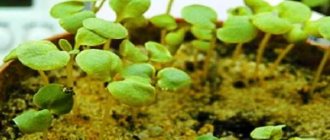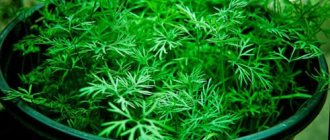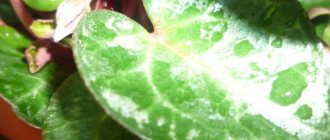Castanospermum (Castanospermum
australe) - Australia is considered the birthplace of the plant. External characteristics are similar to ficus and lithops. The part of the flower located below does not have a stem, for this reason, visually, it seems to be long-legged. Other names for the flower are as follows: black bean, chestnut seed, shore chestnut, chestnut spermum.
In natural conditions, it can reach 35 meters in size, in home floriculture it does not exceed 3 meters. You can often find several flowers in one pot in the store, sprouting they form a gorgeous curly crown.
The root system of the flower is powerfully developed and highly branched, with a brown bark on the stems. The leaves are represented by oval plates, green in color, shiny. The inflorescence can be of various colors: from orange to bright red. Flowers 3-4 centimeters long. Pollination is due to birds and bats.
Castanospermum care at home
Temperature regime
The plant needs warmth all year round. So, it feels best at temperatures from 16 to 23 degrees. It should be borne in mind that in winter the temperature in the room where the room chestnut is located should not drop less than 16 degrees.
Illumination
It feels best in a small partial shade, while you need to protect the plant from direct sunlight.
How to water
Watering in the warm season should be plentiful, but at the same time you need to ensure that the liquid does not stagnate in the soil. For watering, you need to use water exclusively at room temperature. In the cold season, watering should be moderate. Moreover, it must be carried out as the substrate dries.
In winter, the plant needs regular spraying. To do this, take well-settled lukewarm water.
Earth mixture
Suitable soil should be loose and neutral in acidity. To prepare a suitable soil mixture, you need to combine leaf, sod and compost soil, as well as coarse sand, which should be taken in equal proportions. It is also recommended to add some lumps of clay and brick chips. Don't forget a good drainage layer.
Fertilizer
You need to feed a room chestnut all year round once every 2 weeks. For this, organic fertilizers are used.
Transplant features
After the grown castanospermum uses all the beneficial substances that are in the cotyledons, it will be necessary to transplant into a larger pot. At the same time, during transplantation, do not forget that the indoor chestnut has very powerful roots.
Required conditions for growing chestnuts
One of the main advantages of this tree is that it does not need to create any special or additional conditions for growth.
Naturally, with sufficient heat and sunlight, the chestnut will develop much faster and look stronger and more attractive, but in general it is undemanding to these factors, as well as to soil fertility.
However, when planting, it is recommended to observe the following rules related to ensuring conditions, they will help to harden the seedling and increase its degree of resistance to aggressive environmental influences and diseases:
- Initially let the nuts stand for one or several weeks. in a refrigerator or other cold enough place.
- Plant in well-damp soil, preferably during the rainy seasonbecause hardening only occurs under a combination of high humidity and cool conditions.
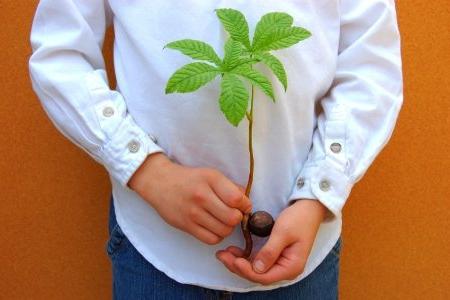
Video review
Castanospermum, or Chestnutseed (Castanospérmum) is a monotypic genus of the legume family (Fabaceae). Lovers of indoor exoticism are known as indoor chestnut, black chestnut, Australian chestnut. In fact, castanospermum is the closest relative of the legume family and has nothing to do with the chestnuts we know, although it has some similarities. Castanospermum naturally grows in rainforests on the east coast of Australia, Queensland and New South Wales, Vanuatu and New Caledonia. There he was nicknamed "Moreton Coast chestnut" and "black beans" because of the large fruits, pods that hang from the branches of trees.
The first scientific description of the indoor chestnut came from the English botanist Allan Cunningham, who initially traveled to Australia as a research botanist and later became the manager of the Sydney Botanic Gardens. The first scientific botanical work describing castanospermum was published in 1830 in the first issue of Hooker's new journal Botanical Miscellany.
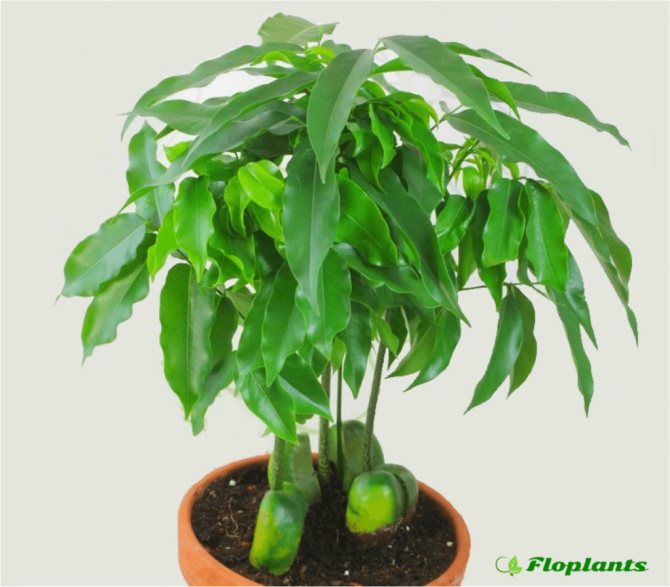

The peculiarity of this ornamental tree is two large cotyledons, which are very similar to the chestnut fruit, they are designed to nourish a young plant.
In nature, castanospermum can grow 15-30 meters, even specimens exceeding 40 meters are known. In indoor conditions, its dimensions are naturally more modest.
When choosing a placement, it should be borne in mind that indoor chestnuts are poisonous plants; do not place the pot in places accessible to children and pets. It is noteworthy that in spite of its toxicity, in Australia its fruits are eaten. In order to neutralize the poison before cooking, the fruits are cut in half and soaked for a long time.
A little about common chestnut
Horse chestnut (ordinary) is a powerful tall (up to 20-25 meters) tree with a spreading crown. Under favorable conditions, trees live for 100 years or more. Attracts in chestnuts, first of all, decorativeness. This wonderful gigantic creation of nature adorns squares and parks at any time of the year. No one is left indifferent by flower pyramids in May-June and bristling hedgehogs of green nut shells in summer. It is easy to find coolness under the crown of a chestnut on the hottest day, and at the time of leaf fall, children and adults enthusiastically collect the fallen seeds.
A strong argument for horse chestnut is its medicinal properties. All parts of the plant are involved in traditional medicine recipes: flowers, bark, nuts, leaves. Powders, broths and ointments treat diseases of the skin, kidneys, joints, stomach and varicose veins. But it should be remembered that the collection and procurement of medicinal raw materials is possible only in ecologically clean areas. One way out is to plant the chestnut yourself.
About caring for indoor chestnut or castanospermum
Temperature: Castanospermum is a thermophilic plant that does not need a cool winter. The optimum temperature for him is 16-23 ° C in summer. In winter, the temperature should not drop below 16 ° C.
Lighting: Indoor chestnut is not very whimsical in terms of lighting, it grows well both in diffused lighting and in light partial shade. It is important to protect the tree from direct sunlight, which can greatly harm its bright green foliage.
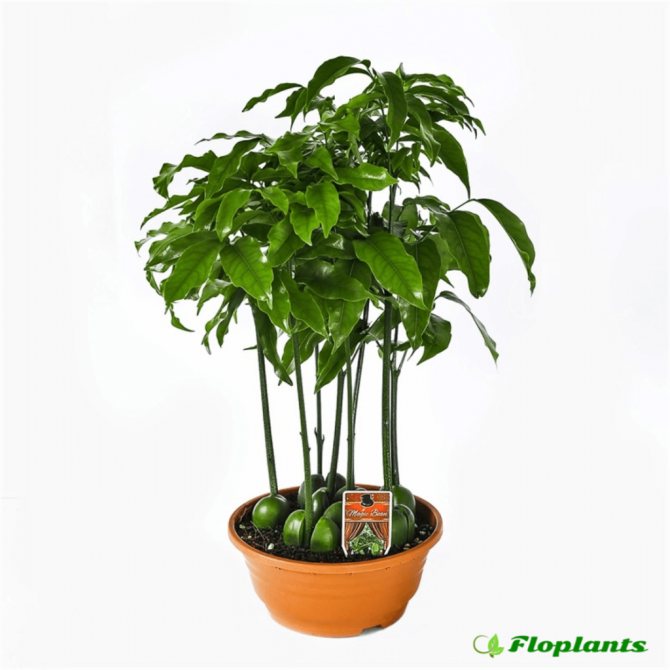

Watering: In summer, they try to water the plant abundantly enough, as the upper layer of the substrate dries out. When watering, keep in mind that the plant is difficult to tolerate stagnant moisture in the soil, try not to overfill.In winter, watering is reduced, but the soil is not overdried, it is watered only after the top layer of the substrate dries out a couple of centimeters deep. Watering castanospermum is carried out with settled water only at room temperature.
Air humidity: An ornamental tree easily tolerates dry air, but in winter, when heating devices are working, in order to avoid problems, it is best to spray it a couple of times a day with warm, settled water.
Fertilizers: Apply all year round, for ornamental-deciduous plants and organic 1 time in 2 weeks.
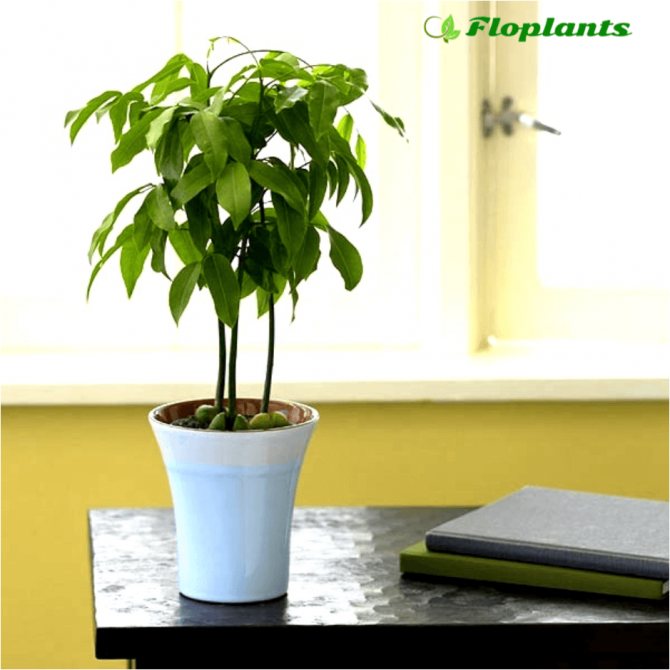

The soil: Castanospermum grows well in a universal substrate, into which vermiculite or sand can be added for looseness. A thick drainage layer is required at the bottom of the pot.
Preparation of planting material
The harvested nuts must undergo some preparation before planting, this process is discussed in more detail below:
- Initially, you need to withstand the planting material in wet sand or earth. A few months before this, the soil must undergo heat treatment in the oven so that, under the influence of high temperatures, all existing fungal spores, parasites and viruses are destroyed. This measure is especially relevant when using sand, since it is the environment in which many microorganisms like to settle and multiply. This process is carried out in advance, since the soil will still need time for the re-emergence of beneficial bacteria in it and the restoration of the natural microflora.
- The container with sand or earth, in which the nuts are placed, should be placed in a sufficiently cool room, the best option is a cellar, basement or basement. If such a stratification is carried out in a city apartment, then the container can be kept in the refrigerator. These measures will stimulate growth and increase the chance of germination of the planting material, however, the container should not be placed in the freezer. If the planting is planned not earlier than spring, but the chestnut should be in such conditions all winter, the sand will need to be periodically additionally moistened.
- For stratification, you can prepare a special nutrient mixture, which is obtained by mixing forest soil and humus of plant origin in equal proportions. Additionally, it is recommended to add dolomite flour, and then thoroughly mix all the components. It is best to keep the nuts in this mixture for at least 4-5 months before planting.
- The shell will need to be softened immediately before planting, otherwise the chestnut will most likely not germinate. To do this, the nuts are placed in a container filled with clean water; you will need to check their condition daily and replace the water. As soon as the upper part of the shell acquires a sufficiently soft structure, the planting material can be considered completely ready.


Decorative chestnut flower in nature
The indoor chestnut flower is very decorative, large, up to 4 cm, red-yellow, with long stamens, a five-membered calyx and a moth-type corolla.
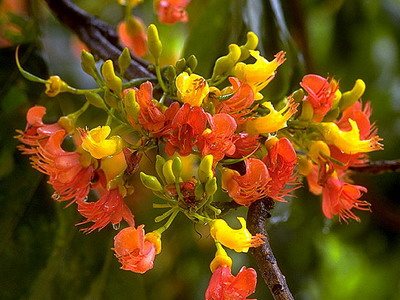

Individual flowers are collected in dense axillary, aciniform inflorescences, in their homeland, in Australia, they bloom in November-December and decorate the tree for six months. Unfortunately, the chestnut does not bloom at home.
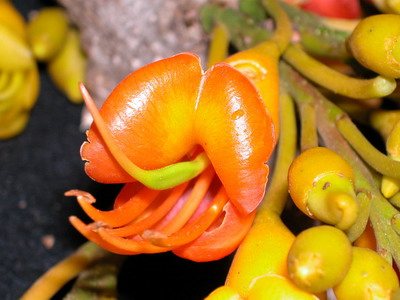

Interestingly, in nature, the chestnut flower is pollinated not by insects, but by bats and birds. After flowering, fruits are formed on it, long, up to 25 cm, cylindrical pods, in an immature form dark green, acquiring a dark brown color as they ripen. Inside each fruit, three to five large, about 3-3.5 cm in diameter, dark brown seeds are formed, which outwardly resemble the fruits of a sowing chestnut, which is why the tree got its name, the locals also call it "chestnut of the Moreton Coast" , or "black beans".
In regions with a warm climate, the crop is grown as an outdoor plant, used for greening cities and gardens, as well as for strengthening and protecting soils from erosion due to a powerful, deeply penetrating root system. As indoor flowers, house chestnuts are also quite popular. Miniature trees have an exotic look, sprouting from the middle of a large seed, which is located on the soil surface and persists for six months, feeding the young shoot.
Due to the high content of saponins, the fruits and leaves of this decorative chestnut are poisonous, which must be taken into account when cultivating it at home.
Interestingly, the Australian aborigines still eat the seeds, for which they are pre-crushed, soaked for a long time, and only then fried or ground into flour.
Gardening Tips
Summing up, you can give the following recommendations that will be useful to gardeners who have decided to plant a chestnut in their garden or plot:
- There are many varieties of chestnut, all of them are differently sensitive to soil quality, climatic conditions, terrain and other factors. For this reason, if the picking of nuts takes place far from the place of the intended planting or planting material is purchased, then it is necessary to find out about its individual characteristics.
- An edible variety of chestnut is suitable for eating, you can try to grow it, then the tree will perform not only decorative functions, but also bring certain benefits. The fruits go well with many dishes, but they require preliminary preparation, they cannot be eaten raw.
- Regardless of the type of chestnut grown, it can be used for medicinal purposes. Virtually all parts of the tree are suitable for this: fruits, seeds, foliage, bark, branches, juice. All of them are part of many traditional medicines, which in most cases are used to relieve pain or normalize the functioning of the digestive system.
Houseplant chestnut at home
Despite the durability and relative unpretentiousness of indoor chestnut, caring for it when growing at home has its own characteristics. In order for a tree to develop well and remain decorative for a long time, it must be provided with conditions close to natural: moderately high temperature throughout the year, from 26 ° C in summer to 18-20 ° C in autumn and winter, and bright diffused lighting. Temperatures below 12 - 16 ° C are not suitable for the plant and can lead to its death. The most optimal placement of the flower on the north-western or eastern window sills, the bright rays of the midday sun on the south side can damage delicate leaves, with a lack of lighting on the northern windows, growth slows down, and the foliage loses its bright color and glossy shine. In the summer, the pot can be taken out to the balcony or into the garden, choosing a warm place protected from winds and direct sunlight; in winter, it must be provided with the best possible lighting.
Which nut to choose for planting
In order to avoid mistakes in the cultivation of chestnuts, we advise you to listen to the opinion of experts and select only fallen nuts. They are used for further germination.
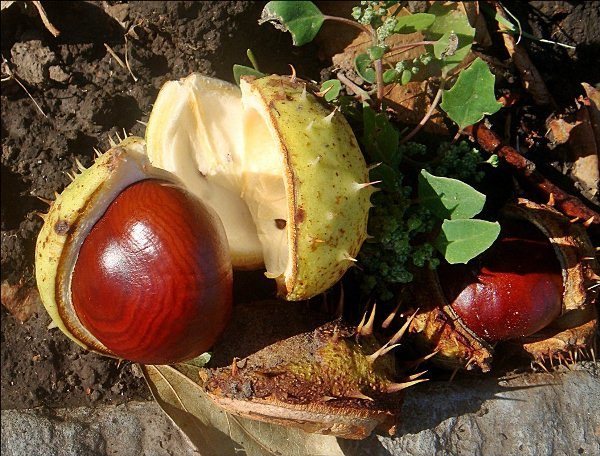

Freshly fallen chestnuts
The fruits should be smooth and beautiful in appearance, without damage or soft spots.... Select firm chestnuts for planting.
If you plan to grow 1-2 trees, take 5 pieces of nuts. Not all of them will sprout, some will die in the garden. The excess can always be offered to neighbors in the country.
It is better to start planting in the fall, after harvesting the fruits. It is not always possible to save nuts until spring without losses. They dry out and lose their germination... If this is not possible, then store the chestnuts until spring in a bag of wet sand.
Reproduction of indoor chestnut flower
For reproduction of an indoor flower, chestnut seeds are used, which are soaked in warm water for a day, then planted in a light substrate, spreading on the surface and for prevention by mulching with a layer of charcoal, and germinated at a temperature of 18 - 25 ° C. After two to three months, sprouts appear from them; to speed up the process, the cotyledons can be treated with phytohormones. Young plants are fed every two to three weeks, transplanted into a large container six months later, after that the cotyledons wrinkle and fall off.
Castanospermum in the photo
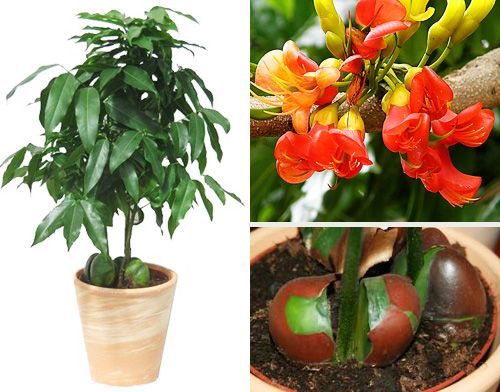

For the normal development of a flower, a high capacity is required, due to the fact that its root system is well developed. The soil mixture should be suitable for ornamental indoor plants. You can also prepare an earthen mixture yourself. To do this, you need to take clay meadow soil and peat. A drainage layer is settled at the bottom of the pot. The plant must be planted so that it is above ground level.
The transplant is carried out in the spring. Young plants need it annually. With age, it will be enough to carry out a transplant once every three years. It is carried out in order to increase the volume of the container.
Will this chestnut blossom
The imagination of every person at the mention of chestnut draws beautiful snow-white fragrant bunches of flowers. Australian chestnut blooms differently. Its flower has nothing to do with its European counterpart. The fruits are a bit similar. That is why it was called chestnut.
What the Australian chestnut flower looks like can only be seen in the wild in November, December. These months are the spring and summer months in Australia. Bright orange flowers with long stamens form large inflorescences, filling the surrounding space with a pleasant aroma.
It looks pretty nice. Not a single case is known that recorded the flowering of the Australian chestnut at home.
Indoor chestnut is intended for those people who prefer lush greenery at home. For this purpose, such a decorative flower is perfect.
Important! The fragrant flowers of the Australian chestnut are pollinated not by insects, but by bats.
A powerful root system, beautiful color and appearance of the plant made it popular for use in decorative landscaping of private plots, city streets, as well as for strengthening slopes from avalanches.
When to transplant outdoors
If the chestnut is transplanted from a pot into open ground, then you also need to know some rules:
- seedlings will take root better if they are kept indoors for up to 1-2 years, by which time the root system will be well formed;
- for planting, leached loamy black soil is needed;
- for each seedling in the garden, you will have to allocate at least 3 m in diameter if you plan to make a chestnut alley;
- the depth and width of the planting holes - not less than 0.5 m;
- it is better to mix the earth from the deepening with humus and sand, add a little nitrogen-phosphorus-potassium fertilizer to the composition of dolomite flour and slaked lime;
- drainage is laid out at the bottom of the planting pits, it can be a mixture of crushed stone (pebbles) and sand;
- the hole is well moistened with water, then a seedling is placed in it;
- the landing mound should rise about 20 cm above the ground, because gradually the soil will shrink under the influence of precipitation.
On a note. If a large chestnut variety is planted, the planting neck should rise 8 cm above the mound.When planting a low-growing crop, it is not necessary to overestimate the seedling.
Eat Served: Water Chestnut Dishes
Chilim is a water nut that is successfully used in cooking. Our ancestors, who knew a lot about healthy eating, gladly made various dishes from water chestnuts.
Many old recipes have been lost, and a modern hostess cannot prepare old Russian treats.But there are many modern recipes that can add variety to a homemade menu.
Water walnut stew
This dish will require:
- 250 grams of shelled water nuts
- 250 grams of apples:
- butter;
- sugar (to taste);
Peel and chop the apples. Put the kernels in a saucepan and simmer until tender, add apples, butter and sugar to them. Simmer until the apples are tender.
Water walnut wrapped in bacon
For the dish you need:
- 1.5 kg fresh bacon;
- 250 grams of canned roguelike fruit.
For the sauce:
- 1 cup tomato or ketchup
- 1 cup brown sugar
- 1 teaspoon Worcester sauce
Cut the bacon into thin slices. Put a flyer in the center of each of them, roll it up and secure with a toothpick. Place the finished rolls in a baking dish and pour over the sauce.
To prepare the sauce, combine the ketchup, sugar and Worcestershire sauce and bring to a boil. The dish is cooked in the oven for 50 minutes at 180 degrees.


Water walnut platter
Damn nut mascot magic
Water walnut has long been considered magical. Therefore, people made talismans from it. They are especially sensitive to the walnut in Altai.
Locals believed that he was able to protect the house from evil and bring good luck. Altai craftsmen still make decorations and souvenirs from a roguelike.
The fruits are first dried and then varnished, sometimes even painted. Funny figurines, magnets and even talismans are made from small nuts, which tourists are happy to buy.
True craftsmen go further and use the flyer even for the original design of accessories and housing.
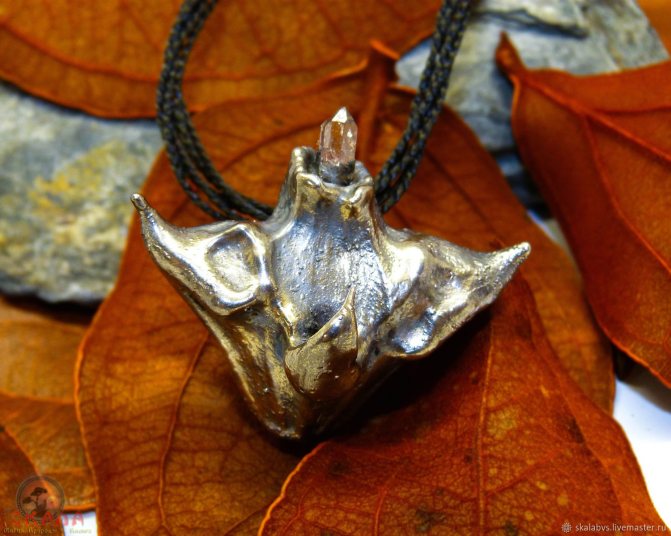

Flyer decoration
Pest and disease control of castanospermum
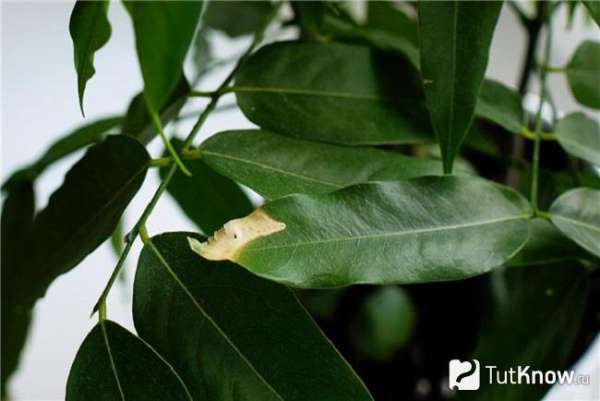

If the growing conditions are violated, then castanospermum can be affected by harmful insects. For example, when the temperature rises and the humidity index decreases, the plant is affected by aphids, scale insects, thrips, mealybugs or spider mites. If pests are found, it is necessary to wash the leaves and trunks under warm shower jets, then you can try to remove insects and their waste products by wiping the leaf plates and stems with soap, oil or alcohol solution, which are prepared as follows:
- For soap, grated laundry soap (about 200 grams) or any dishwashing detergent is used and it is dissolved in a bucket of warm water. Then the mixture is infused for 2-3 hours, filtered and sprayed on the foliage. It is only necessary to protect the roots from getting the drug on the soil.
For oil, a couple of drops of rosemary oil are diluted in a liter of water and then the leaves are wiped with a product.
You should also highlight the following troubles when growing chestnut seeds:
when the level of illumination gives, the leaf plates of castanospermum fade, and if the illumination is increased, then a spot of a light shade appears on the leaves;
if there is a constant flooding of the substrate, then decay of the root system begins;
in the case of poor watering and too dry air, the ends of the leaf plates turn brown and dry out;
with temperature changes, spots appear on the leaves, and they begin to fly around, the same happens when a draft is applied;
Difficulties in growing
Even with good care, chestnut trees are attacked by pests and diseases. This greatly complicates the cultivation of a tree and can ruin all the work done.
Plants are most often affected:
- wood mite;
- chestnut moth;
- powdery mildew.
As a preventive measure, the tree is sprayed with disinfectants twice a month.
It's easy to recognize powdery mildew on chestnuts.... It shows up with characteristic dark or white spots on the leaves. Phosphate fertilizers can significantly reduce the risk of infection.
Chestnut trees with edible fruit are noteworthy. They are not only beautiful but also useful. With good care, seedlings will begin to bear fruit in the 7-8 year of planting.... To avoid mistakes when planting walnut chestnuts, carefully follow the instructions and advice of experienced gardeners. Remember that chestnuts need special care at a young age.
Growing chestnuts from walnuts is quite a fun activity, which, depending on the variety chosen, will allow you to get a tree that performs decorative functions or bears edible fruits. However, for this it will be necessary to take into account the criteria for choosing a nut, to comprehend the planting technology and the rules for the subsequent care of seedlings. All these questions will be discussed in detail in this article.
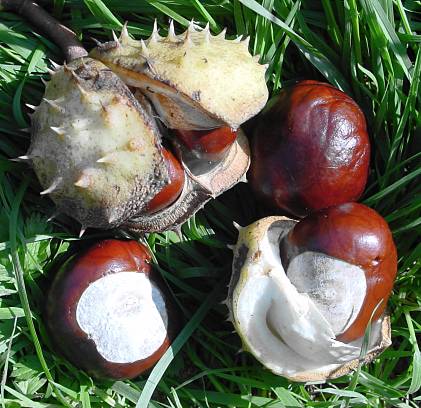

Uses of Australian chestnut
Serves for landscaping streets, garden decoration. Wild chestnut wood is very durable. It is used for the production of furniture, carvings, panels and other joinery. A powerful root system serves to strengthen the soil against erosion. The seeds are poisonous, but when soaked in water, frying and grinding into flour, they become edible.
A miniature, unusual chestnut in a pot is an interior decoration.
See homemade chestnut in the photo:
From Australian forests to our windowsills
The eastern coasts of Australia are practically covered with chestnut trees. An entire chestnut jungle spontaneously filled the humid terrain of the mainland. The region is distinguished by an abundance of rainfall and increased moisture. This tree is not quite familiar to a European inhabitant.
The Australian chestnut has a slightly different look. Evergreen trees with dense oblong leaves. In nature, a tree lives for a long time, 50-150 years, and can reach a height of up to 40 meters. The domesticated crop grows indoors up to three meters. With good care, it will grow forever.


Planting and growing rules
You can try to grow a seedling yourself. This is not difficult, but the seeds must be kept in a humid environment for about five months. They must be collected in the fall and sown in the beds. Experts advise to press them into the ground. To avoid freezing, the entire area is carefully covered with leaves. Chances are good that they will sprout by spring. But it is better to sow with a margin. The growth process of a chestnut tree is long, so you should not expect a spectacular seedling in a year. A beautiful tree can be observed in ten years.
If you buy a seedling in advance, then the task becomes easier. In this case, the main thing is to choose a well-lit area with a sufficient amount of space (at least four meters from the rest of the plants). This guarantees a beautiful crown. It is not necessary to deepen the root neck thoroughly. It should be five centimeters elevated above the soil level. The soil is compacted, so the ground will become level.


Success secrets
Indoor Chestnut feels great at moderate air temperatures in summer, preferably + 23–26 ° С. With the onset of winter, the plant is recommended to create cool temperature conditions, but the thermometer should not drop below + 12 ° C.
Chestnutospermum prefers bright, diffused light, but direct sunlight can cause leaf burns.Therefore, it is recommended to place a tree on the east or west side of the room, by the window. In the northern part, the plant will lack lighting, as a result, the leaves will lose their decorative effect.
On short winter days, Kashtanospermum should be additionally illuminated.
Since indoor Chestnut is a moisture-loving tropical plant, during the hot summer period it must be regularly and moderately watered with warm, settled water, preventing the soil from drying out. During the rest period, watering is reduced to a minimum. It is also impossible to fill the plant, and there should be no stagnation of water in the pot.
The endemic representative of the genus prefers humid air, therefore, the plant must be sprayed daily in the spring and summer with well-filtered water. In the cold season, crown leaves are also moistened if the tree is located near central heating radiators. From time to time, you can give Kashtanospermum a warm shower, covering the soil from excess moisture.
Seed selection
To get a good harvest, you need to start by choosing the right planting material. Experts strongly recommend using for germination only those fruits that themselves fell from the tree to the ground.


To select a seed, it is imperative to conduct a visual examination of the fetus. The nut must be smooth and firm. There can be no dents, cracks or other defects on the surface.
For 1-2 chestnuts, it is best to take about 5 fruits. There is no guarantee that they will all germinate. In addition, there is a possibility that several seedlings will die in the garden when transplanting or failing to withstand severe weather conditions. If all the trees grow well and take root, then the excess plants can be given to neighbors or friends. Each person will be happy to acquire a storehouse of vitamins and minerals in their own area.
Interesting facts about the castanospermum flower


If climatic conditions permit, it is customary to grow chestnut seeds as a street crop or as a home ornamental plant. Castanospermum wood is very similar to walnut wood, it is soft, fine-grained and has excellent polishing properties.
Despite the fact that the seeds of the plant are poisonous, but if they are soaked in water, fried or ground into flour, then they are edible.
The alkaloid castanospermine provides a high toxicity to the plant, so this should be taken into account when growing a tree in a room. It is necessary to make sure that small children or pets do not have access to the German. Not only the leaves are poisonous, but also the seeds, so it is extremely important that they do not fall into the hands or on the mucous membrane of the mouth. Despite this, indigenous peoples use these parts of the plant after pretreatment for the treatment of HIV-infected or patients suffering from cancer.
More about growing castanospermum:
Latin name: Castanospermum
Kashtanospermum species
Photo gallery
Content
- 1. Description
- 2. Growing
- 3. Diseases and pests
- 4. Reproduction
- 5. First steps after purchase
- 6. Secrets of success
- 7. Possible difficulties
The genus is only a single species of evergreen, perennial trees of the legume family. Under natural conditions of growth, some specimens reach up to 40 m in height. Their distribution area is the humid tropics of Australia.
People call Kashtanospermum room Chestnut. It should be borne in mind that the name of the genus has nothing in common with the Chestnut known in our latitudes.
Kashtanospermum is a tall, slowly growing tree with an emerald crown of oblong, elliptical, slightly curved leaves, up to 15 cm long. The powerful trunk is covered with a smooth dark brown bark.
In summer, the woody plant enters the budding period. On young branches, colorful, bright inflorescences of red-yellow, two-colored corollas are formed.Chestnutospermum blooms and produces fruits only in natural conditions of growth. The fruit of the tree is a long, cylindrical pod with black, chestnut-shaped seeds in three to five segments.
The only species of Australian Chestnutospermum has a characteristic feature that gives the plant a showiness - its large cotyledons, which are located at the base of the trunk on the soil surface. By their presence, the age of the tree is judged: for some time, a young specimen takes nutrients from these organs.
Thanks to its good pruning ratio, Chestnutospermum provides an excellent opportunity to form a spectacular bonsai tree for interior decoration. However, it should be borne in mind that all parts of it are poisonous and pose a certain danger to children and animals.
Why is water nut valuable?
The kernel of the chilim fruit is extremely high in calories. It contains up to 50-55% starch. Thanks to this indicator, the nutritional value reaches 180 kilocalories per 100 grams.
The nut also contains:
- ash - 25%;
- water - 18%
- nitrogenous substances -12%;
- fiber - 1.5%;
- oil - 0.5%


Water nut fruit is nutritious and healthy
First steps after purchase
To purchase a healthy specimen of Kashtanospermum for growing indoors, it is recommended to first examine its appearance. The slightest traces of damage on the leaves and trunk should alert the buyer: perhaps this species is affected by pests or common diseases.
You also need to pay attention to the location of the container with the plant: it is not recommended to buy a copy located opposite the door or in a draft.
After transportation, Kashtanospermum is slightly shaded, if necessary, watered with warm, filtered water and be sure to spray the decorative leaves of the crown.
Lighting
Indoor chestnut prefers bright diffused lighting; in the daytime it must be shaded from direct sunlight. He feels good on the eastern and north-western window sills and loggias. Sunlight in the morning and evening is quite enough for the plant. It is these sides in the apartment that will give the plant the necessary diffused lighting that it loves.
Direct sunlight is detrimental to the plant: the delicate crown will quickly receive burns, which will adversely affect its development. But the lack of light is not the best option. The leaves will become faded and dull.
In the summer, the chestnut can be taken out into the open air, having previously protected the place from direct sunlight.
Read also Digested jam how to fix
Watering the plant
From spring to autumn, chestnutospermum requires abundant watering without overdrying the earthen coma. Water for irrigation must be defended so that it becomes soft. In winter, watered less often, with drying, but not overdrying the soil in the pot. In general, chestnuts are easier to tolerate a lack of water than excess water. By filling the plant, you risk losing it, as the root system will gradually begin to rot and the chestnut will die. So act carefully, otherwise, out of inexperience, you will ruin the plant.
In nature, this plant often grows along the banks of rivers, therefore it loves humid air very much. Regular spraying and warm showers are very beneficial for the growth and development of indoor chestnuts.
Spraying is carried out with settled warm water. This is especially true in winter, as heating makes the air completely dry. Chestnut begins to suffer from dry air, and a warm everyday shower will be a real treat. You just need to remember that in no case should you put the plant next to the batteries. Water droplets that remain on the leaves can cause inconvenience to the plant, as they will lead to burns. For the same reason, it must be hidden from the sun in summer. It grows well on the street, but again it requires shelter from direct sunlight.
Sowing seedlings in pots
I put the hatched nuts in prepared pots with moistened earth. I had very little soil available, and there should be no pulling with the landing. Therefore, the cups are tiny. Ideally, 0.5 liter containers would be suitable. This is important: we put the nuts sprout at the bottom.
The landing should not be deepened. I sprinkle the chestnuts with a small amount of soil, water them and put them on the windowsill. It is recommended to trim the tip of the sprout with a sharp blade, followed by disinfection of the cut. I myself did not perform such an operation, since I do not find it particularly necessary. All further care consists in timely watering. If you fill the planting, the seed will rot. With a lack of moisture, it will dry out. After another week, a powerful sprout will appear (to match the nut).
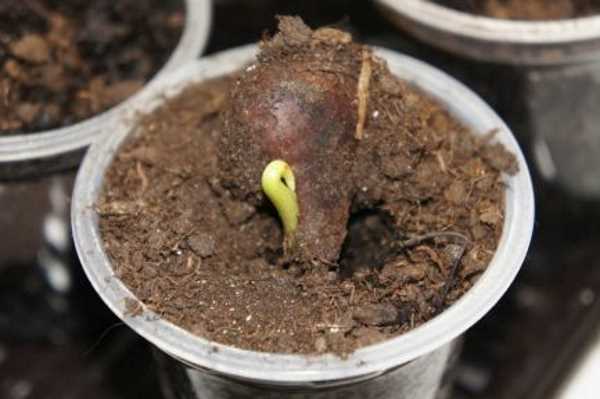

Do not rush to throw away the planting if you have not seen an escape after 2-3 weeks. For me personally, one nut came up in a month. Of the 20 chestnuts I have planted, 16 have grown. Seedlings need a lot of light.
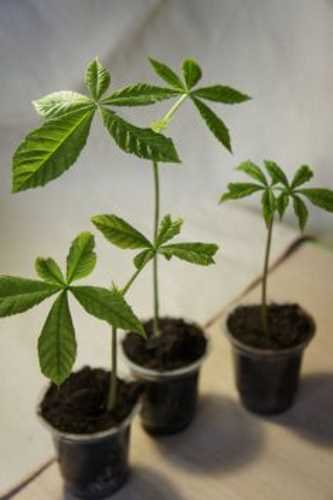

You can start hardening the plants a couple of weeks before planting on the site, taking them out to the open balcony. First year chestnuts should be planted in a makeshift nursery. It will be a corner of the garden, protected from windmills and the scorching sun. Plant two-year-olds in a permanent place next spring.
Problems
Indoor chestnut is attacked by the same insect parasites and microorganisms as other plants. These are scale insects, spider mites, scale insects, thrips, root rot, powdery mildew. Traditional methods and means of processing - insecticides, fungicides, folk remedies. Harm to castnospermum and unfavorable indoor conditions.
Dry air and lack of moisture in the soil cause the leaves to darken. Uneven lighting results in white spots on the foliage. In winter, the plant must be additionally illuminated with a phytolamp so that the leaves do not turn pale and do not look faded. But in the summer they can turn yellow and fall off due to direct sunlight, the shade of the plant is vital.
In winter, the leaves will wither and crumble due to the low temperature, it should not fall below +18 degrees.
Dry indoor air causes the tips of the leaves to turn brown, if you notice this problem, spray the plant with water.
As you can see, indoor chestnut is a rather capricious plant, it is not so easy to grow it, but everything comes with time - both experience and understanding of its features. It is best to keep it at home along with flowers that do well in a similar environment.


